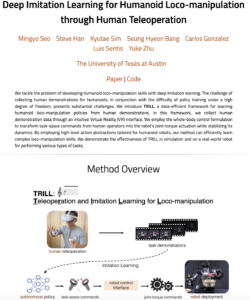Check out a preprint of our latest collaborative work on stress response of people to walking robots using physiological sensors and survey analysis.
Showtime! ASE389 Design of Human Centered Robots
Apptronik Deploys Humanoid Robots at Mercedes-Benz
SXSW 2024 Fireside Chat Recording Between Luis Sentis and AGI Futurologist Ana Arriola-Kanada
Deep Imitation Learning for Humanoid Loco-manipulation through Human Teleoperation
PI Luis Sentis Organizes the IEEE RAS Humanoids 2023 Conference in Austin
Below is the movie reel summarizing the IEEE RAS International Conference on Humanoid Robots 2023 held last week here at The University of Texas at Austin. It was truly fantastic. Thank you for your help to IEEE RAS, the organizing committee, the sponsors, the plenary speakers, Texas Robotics, the EER building personnel, the volunteers, The University of Texas at Austin, and all attendees!
The list of sponsors for Humanoids’23 in Austin on December 12-14 is growing. Click below to see the current sponsors, the floor plan, and the details of the beautiful and spacious EER building where all exhibitions by sponsors, competitors, paper speakers, poster presenters, and workshops will take place.
Humanoid Robot Deep Imitation Learning (TRILL) Website
DRACO 3 Cooks Ramen
What does it take to cook a meal with a humanoid robot? Students Steve Han, Mingyo Seo, Hye-Young Chung, Kyutae Sim, Yifan Xu, Yuke Zhu, Seung Hyeon Bang and Carlos Gonzalez, myself and Prof. Yuke Zhu team up to explore this question as well as how we work together as a team from a Team Science perspective.








